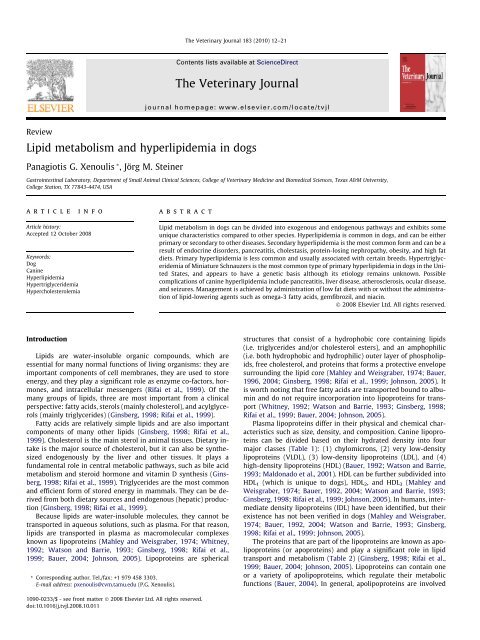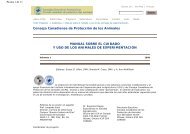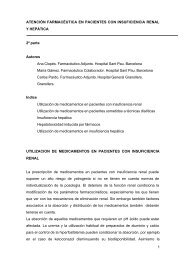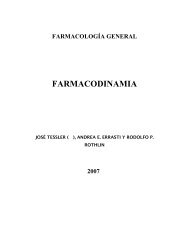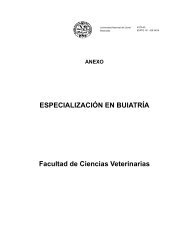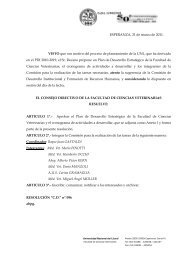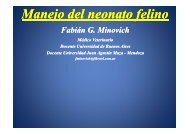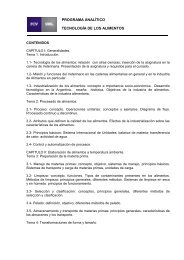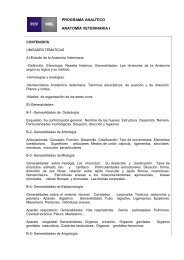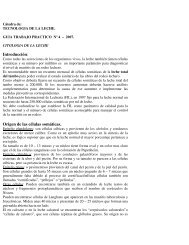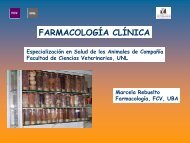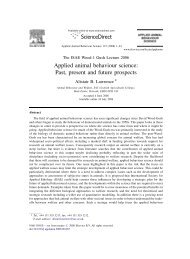Lipid metabolism and hyperlipidemia in dogs
Lipid metabolism and hyperlipidemia in dogs
Lipid metabolism and hyperlipidemia in dogs
You also want an ePaper? Increase the reach of your titles
YUMPU automatically turns print PDFs into web optimized ePapers that Google loves.
P.G. Xenoulis, J.M. Ste<strong>in</strong>er / The Veter<strong>in</strong>ary Journal 183 (2010) 12–21 15Fig. 1. Lipemia. Serum samples with normal triglyceride concentrations are clear (left tube). As the serum triglyceride concentration <strong>in</strong>creases, serum becomes turbid (middletube) <strong>and</strong> ultimately lactescent (right tube).Fig. 2. Chylomicron test. The picture on the left shows a lipemic serum sample from a dog with hypertriglyceridemia right after separation of the serum from the clot. Thesame serum sample is shown on the right after overnight refrigeration (chylomicron test). The formation of a cream layer due to hyperchylomicronemia is obvious. Therema<strong>in</strong><strong>in</strong>g serum below the cream layer is clear (although hemolytic), which suggests that other classes of lipoprote<strong>in</strong>s are not <strong>in</strong>creased <strong>in</strong> this patient.
18 P.G. Xenoulis, J.M. Ste<strong>in</strong>er / The Veter<strong>in</strong>ary Journal 183 (2010) 12–211977; Whitney, 1992; Ford, 1993, 1996; Bauer, 1995, 2004; Williams,1996; Williams <strong>and</strong> Ste<strong>in</strong>er, 2005). In addition, the highprevalence of pancreatitis <strong>in</strong> M<strong>in</strong>iature Schnauzers has been attributedto the fact that <strong>dogs</strong> of this breed commonly develop hypertriglyceridemia(Whitney, 1992; Williams, 1996; Ford, 1996;Williams <strong>and</strong> Ste<strong>in</strong>er, 2005). Available cl<strong>in</strong>ical <strong>and</strong> experimentaldata to support the above hypotheses are limited, however. Pancreatitishas been shown to develop <strong>in</strong> <strong>dogs</strong> after feed<strong>in</strong>g highfat, low prote<strong>in</strong> diets, <strong>and</strong> is more severe when <strong>in</strong>duced <strong>in</strong> <strong>dogs</strong>be<strong>in</strong>g fed a high fat diet (L<strong>in</strong>dsay et al., 1948; Goodhead, 1971).Also, <strong>in</strong> vitro studies on an isolated can<strong>in</strong>e pancreas showed thathigh triglyceride concentrations can <strong>in</strong>duce pancreatitis possiblythrough the release of free fatty acids (Saharia et al., 1977).Cl<strong>in</strong>ical studies have shown an association between hypertriglyceridemia<strong>and</strong> pancreatitis <strong>in</strong> <strong>dogs</strong>, although it is not knownwhether hypertriglyceridemia was the cause or a result of pancreatitis,or just an <strong>in</strong>cidental f<strong>in</strong>d<strong>in</strong>g <strong>in</strong> some cases (Rogers et al.,1975a,b; Whitney et al., 1987; Cook et al., 1993; Hess et al.,1998, 1999; Williams <strong>and</strong> Ste<strong>in</strong>er, 2005). In a prelim<strong>in</strong>ary study,hypertriglyceridemia exceed<strong>in</strong>g 10.17 mmol/L (900 mg/dL) wasfound to be associated with an <strong>in</strong>creased risk for pancreatitis <strong>in</strong>M<strong>in</strong>iature Schnauzers, <strong>and</strong> that might also be true for <strong>dogs</strong> of otherbreeds (Xenoulis et al., 2006). Secondary <strong>hyperlipidemia</strong> seen <strong>in</strong><strong>dogs</strong> with some endocr<strong>in</strong>opathies (e.g., hyperadrenocorticism) orobesity may be responsible for the <strong>in</strong>creased risk for pancreatitisassociated with these diseases (Chikamune et al., 1995; Hesset al., 1999, 2000). Based on these studies, an association betweenhypertriglyceridemia <strong>and</strong> pancreatitis <strong>in</strong> <strong>dogs</strong> is obvious, but acause-<strong>and</strong>-effect relationship has not been established yet.Hepatobiliary diseaseCl<strong>in</strong>ical studies <strong>and</strong> anecdotal observations suggest that twoconditions of the liver might be associated with hypertriglyceridemia<strong>in</strong> <strong>dogs</strong>: vacuolar hepatopathy <strong>and</strong> gallbladder mucocele (Center,1996; Scherk <strong>and</strong> Center, 2005). Hyperlipidemia-associatedvacuolar hepatopathy has been more commonly associated withhypertriglyceridemia <strong>in</strong> M<strong>in</strong>iature Schnauzers (Center, 1996). Gallbladdermucocele has been commonly reported <strong>in</strong> dog breeds thatare predisposed to idiopathic <strong>hyperlipidemia</strong> (e.g. M<strong>in</strong>iatureSchnauzers <strong>and</strong> Shetl<strong>and</strong> Sheep<strong>dogs</strong>) <strong>and</strong> <strong>hyperlipidemia</strong> has beenimplicated <strong>in</strong> gallbladder disease <strong>in</strong> humans (Bol<strong>and</strong> et al., 2002;Pike et al., 2004; Aguirre et al., 2007). In a recent study, an associationbetween gallbladder mucocele formation <strong>and</strong> dyslipidemias(hypertriglyceridemia <strong>and</strong> hypercholesterolemia) was described<strong>in</strong> Shetl<strong>and</strong> Sheep<strong>dogs</strong> (Aguirre et al., 2007). In this study, manyof the <strong>dogs</strong> with a gallbladder mucocele had no cl<strong>in</strong>ical signs orbiochemical abnormalities, except for an <strong>in</strong>creased serum ALPactivity <strong>in</strong> some cases (Aguirre et al., 2007). Although asymptomatic<strong>in</strong> many cases, both vacuolar hepatopathy <strong>and</strong> gallbladdermucocele can potentially be fatal (Center, 1996; Aguirre et al.,2007).Idiopathic hypertriglyceridemia (especially P4.52 mmol/L or400 mg/dL) was found to be associated with <strong>in</strong>creased serum liverenzyme activities <strong>in</strong> healthy M<strong>in</strong>iature Schnauzers (Xenouliset al., 2008). In that study, 60% <strong>and</strong> 45% of the M<strong>in</strong>iature Schnauzerswith serum triglyceride concentrations P4.52 mmol/L(400 mg/dL) had <strong>in</strong>creased ALP <strong>and</strong> ALT activities, respectively.In contrast, 0% <strong>and</strong> 9% of the M<strong>in</strong>iature Schnauzers with normalserum triglyceride concentrations had <strong>in</strong>creased ALP <strong>and</strong> ALTactivities, respectively. Whether or not such cases require additionaldiagnostic <strong>in</strong>vestigation of the cause of the liver disease rema<strong>in</strong>sto be determ<strong>in</strong>ed. Given the fact that <strong>in</strong> this study most<strong>dogs</strong> had serum elevations of more than one liver enzyme activitiesthat are often considered significant (>2 times the upper limitof the reference range), additional diagnostic work-up or retest<strong>in</strong>gwould seem appropriate.AtherosclerosisAlthough <strong>dogs</strong> appear to be resistant to atherosclerosis due totheir lipoprote<strong>in</strong> composition <strong>and</strong> <strong>metabolism</strong>, they have been reportedto develop atherosclerosis <strong>in</strong> both experimental <strong>and</strong> cl<strong>in</strong>icalstudies (Mahley et al., 1974, 1977; Liu et al., 1986; Kagawa et al.,1998; Hess et al., 2003). Spontaneous atherosclerosis has been reported<strong>in</strong> <strong>dogs</strong> ma<strong>in</strong>ly <strong>in</strong> association with secondary hypercholesterolemiadue to endocr<strong>in</strong>opathies (Liu et al., 1986; Hess et al.,2003). In one study, 60% of 30 <strong>dogs</strong> with atherosclerosis had hypothyroidism<strong>and</strong> 20% had diabetes mellitus (Hess et al., 2003).Ocular diseaseSeveral ocular manifestations of <strong>hyperlipidemia</strong>, such as lipemiaret<strong>in</strong>alis, lipemic aqueous, <strong>and</strong> lipid keratopathy have been reported<strong>in</strong> <strong>dogs</strong> (Crisp<strong>in</strong>, 1993). Recently, solid <strong>in</strong>traocularxanthogranuloma formation was reported as a unique disorder ofhyperlipidemic M<strong>in</strong>iature Schnauzers (Zafross <strong>and</strong> Dubielzig,2007).Other possible complications of <strong>hyperlipidemia</strong>Seizures <strong>and</strong> other neurologic signs have been reported to occurpotentially as a result of <strong>hyperlipidemia</strong> <strong>in</strong> <strong>dogs</strong> (Rogers et al.,1975a; Bodk<strong>in</strong>, 1992; Bauer, 1995; Vitale <strong>and</strong> Olby, 2007). However,the relationship between these disorders rema<strong>in</strong>s obscure<strong>in</strong> <strong>dogs</strong>. Also, some authors report that <strong>hyperlipidemia</strong> can causecl<strong>in</strong>ical signs of abdom<strong>in</strong>al pa<strong>in</strong>, lethargy, vomit<strong>in</strong>g, <strong>and</strong>/or diarrheawithout evidence of pancreatitis or other diseases (Ford,1993, 1996). This is highly speculative, however, because publishedreports are lack<strong>in</strong>g <strong>and</strong>, given the difficulty <strong>in</strong> diagnos<strong>in</strong>gpancreatitis especially <strong>in</strong> past decades, pancreatitis could have easilybeen missed.Treatment of <strong>hyperlipidemia</strong>The first step <strong>in</strong> the treatment of <strong>hyperlipidemia</strong> is the determ<strong>in</strong>ationof whether the patient has a primary or a secondary lipiddisorder (Rogers, 1977; Ford, 1996; Johnson, 2005). Thus, specificdiagnostic <strong>in</strong>vestigations should be performed <strong>in</strong> order to diagnoseor rule out diseases that can cause secondary <strong>hyperlipidemia</strong>.Treatment of secondary <strong>hyperlipidemia</strong> relies on the successfultreatment of the primary disorder after which <strong>hyperlipidemia</strong> usuallyresolves (Rogers, 1977; Whitney, 1992; Ford, 1996; Johnson,2005). Resolution of secondary <strong>hyperlipidemia</strong> after treatment ofthe cause should always be confirmed by laboratory test<strong>in</strong>g (usually4–6 weeks after correction of the primary disease). If <strong>hyperlipidemia</strong>has not resolved, wrong diagnosis, <strong>in</strong>effective treatment, orconcurrent primary or secondary <strong>hyperlipidemia</strong> of other causeshould be considered.After secondary causes of <strong>hyperlipidemia</strong> have been ruled out, apresumptive diagnosis of a primary lipid disorder can be made(Whitney, 1992). It has been recommended that hypertriglyceridemiathat exceeds 5.65 mmol/L (500 mg/dL) should be treated <strong>in</strong> orderto avoid possible complications (Whitney, 1992; Ford, 1996). Italso has been recommended that the treatment goal should be tokeep serum triglyceride concentrations
P.G. Xenoulis, J.M. Ste<strong>in</strong>er / The Veter<strong>in</strong>ary Journal 183 (2010) 12–21 191996; Johnson, 2005). Dogs with primary <strong>hyperlipidemia</strong> should beoffered a low fat diet throughout their lives (Ford, 1996). Diets thatconta<strong>in</strong> less than 20 grams of fat per 1000 kcal are recommended(Ford, 1996; Johnson, 2005; Elliott, 2005). Many commerciallyavailable diets are suitable for <strong>dogs</strong> with primary <strong>hyperlipidemia</strong>.Treats <strong>and</strong> table scraps should be avoided unless they are low <strong>in</strong>fat (Elliott, 2005).Serum lipid concentrations should be re-evaluated after feed<strong>in</strong>ga low fat diet for about 4–8 weeks (Ford, 1996). If serum triglycerideconcentration has decreased to
20 P.G. Xenoulis, J.M. Ste<strong>in</strong>er / The Veter<strong>in</strong>ary Journal 183 (2010) 12–21Burkhard, M.J., Meyer, D.J., 1995. Causes <strong>and</strong> effects of <strong>in</strong>terference with cl<strong>in</strong>icallaboratory measurements <strong>and</strong> exam<strong>in</strong>ations. In: Bonagura, J.D. (Ed.), Kirk’sCurrent Veter<strong>in</strong>ary Therapy XII. WB Saunders, Philadelphia, Pennsylvania, pp.14–20.Cameron, J.L., Capuzzi, D.M., Zuidema, G.D., Margolis, S., 1974. Acute pancreatitiswith hyperlipemia. Evidence for a persistent defect <strong>in</strong> lipid <strong>metabolism</strong>.American Journal of Medic<strong>in</strong>e 56, 482–487.Center, S.A., Smith, C.A., Wilk<strong>in</strong>son, E., Erb, H.N., Lewis, R.M., 1987.Cl<strong>in</strong>icopathological, renal immunofluorescent, <strong>and</strong> light microscopic featuresof glomerulonephritis <strong>in</strong> the dog – 41 Cases (1975–1985). Journal of theAmerican Veter<strong>in</strong>ary Medical Association 190, 81–90.Center, S.A., 1996. Hepatic lipidosis, glucocorticoid hepatopathy, vacuolarhepatopathy, storage disorders, amyloidosis, <strong>and</strong> iron toxicity. In: Strombeck,D.R., Guilford, W.G., Center, S.A., Williams, D.A., Meyer, D.J. (Eds.), Strombeck’sSmall Animal Gastroenterology. WB Saunders, Philadelphia, Pennsylvania, pp.766–801.Chikamune, T., Katamoto, H., Ohashi, F., Shimada, Y., 1995. Serum lipid <strong>and</strong>lipoprote<strong>in</strong> concentrations <strong>in</strong> obese <strong>dogs</strong>. Journal of Veter<strong>in</strong>ary Medical Science57, 595–598.Chikamune, T., Katamoto, H., Nomura, K., Ohashi, F., 1998. Lipoprote<strong>in</strong> profile <strong>in</strong>can<strong>in</strong>e pancreatitis <strong>in</strong>duced with oleic acid. Journal of Veter<strong>in</strong>ary MedicalScience 60, 413–421.Chuang, J.H., Shieh, C.S., Chang, N.K., Chen, W.J., Lo, S.K., 1995. Metabolic effect ofparenteral nutrition <strong>in</strong> <strong>dogs</strong> with obstructive jaundice. Journal of the AmericanCollege of Nutrition 14, 197–201.Connelly, P.W., 1999. The role of hepatic lipase <strong>in</strong> lipoprote<strong>in</strong> <strong>metabolism</strong>. Cl<strong>in</strong>icaChimica Acta 286, 243–255.Cook, A.K., Breitschwerdt, E.B., Lev<strong>in</strong>e, J.F., Bunch, S.E., L<strong>in</strong>n, L.O., 1993. Risk factorsassociated with acute pancreatitis <strong>in</strong> <strong>dogs</strong>: 101 cases (1985–1990). Journal ofthe American Veter<strong>in</strong>ary Medical Association 203, 673–679.Cook, A.K., Cowgill, L.D., 1996. Cl<strong>in</strong>ical <strong>and</strong> pathological features of prote<strong>in</strong>-los<strong>in</strong>gglomerular disease <strong>in</strong> the dog: a review of 137 cases (1985–1992). Journal of theAmerican Animal Hospital Association 32, 313–322.Crisp<strong>in</strong>, S.M., 1993. Ocular manifestations of hyperlipoprote<strong>in</strong>emia. Journal of SmallAnimal Practice 34, 500–506.Danielsson, B., Ekman, R., Johansson, B.G., Petersson, B.G., 1977. Plasma lipoprote<strong>in</strong>changes <strong>in</strong> experimental cholestasis <strong>in</strong> dog. Cl<strong>in</strong>ica Chimica Acta 80, 157–170.Deckelbaum, R.J., Eisenberg, S., Oschry, Y., Butbul, E., Sharon, I., Olivecrona, T., 1982.Reversible modification of human plasma low-density lipoprote<strong>in</strong>s towardtriglyceride-rich precursors – a mechanism for los<strong>in</strong>g excess cholesterol esters.Journal of Biological Chemistry 257, 6509–6517.Dibartola, S.P., Tarr, M.J., Parker, A.T., Powers, J.D., Pultz, J.A., 1989. Cl<strong>in</strong>icopathologicf<strong>in</strong>d<strong>in</strong>gs <strong>in</strong> <strong>dogs</strong> with renal amyloidosis – 59 cases (1976–1986). Journal of theAmerican Veter<strong>in</strong>ary Medical Association 195, 358–364.Dibartola, S.P., Tarr, M.J., Webb, D.M., Giger, U., 1990. Familial renal amyloidosis <strong>in</strong>Ch<strong>in</strong>ese Shar-Pei <strong>dogs</strong>. Journal of the American Veter<strong>in</strong>ary Medical Association197, 483–487.Diez, M., Michaux, C., Jeusette, I., Baldw<strong>in</strong>, P., Istasse, L., Biourge, V., 2004. Evolutionof blood parameters dur<strong>in</strong>g weight loss <strong>in</strong> experimental obese Beagle <strong>dogs</strong>.Journal of Animal Physiology <strong>and</strong> Animal Nutrition 88, 166–171.Dixon, R.M., Reid, S.W., Mooney, C.T., 1999. Epidemiological, cl<strong>in</strong>ical,haematological <strong>and</strong> biochemical characteristics of can<strong>in</strong>e hypothyroidism.Veter<strong>in</strong>ary Record 145, 481–487.Downs, L.G., Crisp<strong>in</strong>, S.M., Legr<strong>and</strong>-defret<strong>in</strong>, V., PerezCamargo, G., McCapp<strong>in</strong>, T.,Bolton, C.H., 1997. The effect of dietary changes on plasma lipids <strong>and</strong>lipoprote<strong>in</strong>s of six Labrador Retrievers. Research <strong>in</strong> Veter<strong>in</strong>ary Science 63,175–181.Elliott, D.A., 2005. Dietary <strong>and</strong> medical considerations <strong>in</strong> <strong>hyperlipidemia</strong>. In:Ett<strong>in</strong>ger, S.J., Feldman, E.C. (Eds.), Textbook of Veter<strong>in</strong>ary Internal Medic<strong>in</strong>e.Saunders Elsevier, St. Louis, Missouri, pp. 592–595.Feldman, E.C., Nelson, R.W., 2004. Can<strong>in</strong>e <strong>and</strong> Fel<strong>in</strong>e Endocr<strong>in</strong>ology <strong>and</strong>Reproduction. Saunders, St. Louis, Missouri. pp. 85–645.Ford, R.B., 1993. Idiopathic hyperchylomicronemia <strong>in</strong> M<strong>in</strong>iature Schnauzers. Journalof Small Animal Practice 34, 488–492.Field<strong>in</strong>g, C.J., Field<strong>in</strong>g, P.E., 1995. Molecular physiology of reverse cholesteroltransport. Journal of <strong>Lipid</strong> Research 36, 211–228.Ford, R.B., 1996. Cl<strong>in</strong>ical management of lipemic patients. Compendium onCont<strong>in</strong>u<strong>in</strong>g Education for the Practic<strong>in</strong>g Veter<strong>in</strong>arian 18, 1053–1060.Fortson, M.R., Freedman, S.N., Paul, D., 1995. Cl<strong>in</strong>ical assessment of hyperlipidemicpancreatitis. American Journal of Gastroenterology 90, 2134–2139.Froyl<strong>and</strong>, L., Asiedu, D.K., Vaagenes, H., Garras, A., Lie, O., Totl<strong>and</strong>, G.K., Berge, R.K.,1995. Tetradecylthioacetic acid <strong>in</strong>corporated <strong>in</strong>to very low density lipoprote<strong>in</strong>:changes <strong>in</strong> the fatty acid composition <strong>and</strong> reduced plasma lipids <strong>in</strong> cholesterolfedhamsters. Journal of <strong>Lipid</strong> Research 36, 2529–2540.G<strong>in</strong>sberg, H.N., 1998. Lipoprote<strong>in</strong> physiology. Endocr<strong>in</strong>ology <strong>and</strong> MetabolismCl<strong>in</strong>ics of North America 27, 503–519.Gleeson, J.M., Hejazi, J.S., Kwong, L., Chan, I.F., Le, T., Alberts, A.W., Wilson, D.E.,1990. Plasma apolipoprote<strong>in</strong>-E, high-density lipoprote<strong>in</strong>-1 (Hdl1) <strong>and</strong> ur<strong>in</strong>arymevalonate excretion <strong>in</strong> pancreatectomized diabetic <strong>dogs</strong> – effects of <strong>in</strong>sul<strong>in</strong><strong>and</strong> lovastat<strong>in</strong>. Atherosclerosis 84, 1–12.Goodhead, B., 1971. Importance of nutrition <strong>in</strong> the pathogenesis of experimentalpancreatitis <strong>in</strong> the dog. Archives of Surgery 103, 724–727.Guyton, A.C., Hall, J.E., 2000. Digestion <strong>and</strong> absorption <strong>in</strong> the gastro<strong>in</strong>test<strong>in</strong>al tract.In: Guyton, A.C., Hall, J.E. (Eds.), Textbook of Medical Physiology. WB Saunders,Philadelphia, Pennsylvania, pp. 754–763.Havel, R.J., 1969. Pathogenesis, differentiation <strong>and</strong> management ofhypertriglyceridemia. Advances <strong>in</strong> Internal Medic<strong>in</strong>e 15, 117–154.Hess, R.S., Saunders, H.M., Van W<strong>in</strong>kle, T.J., Shofer, F.S., Washabau, R.J., 1998.Cl<strong>in</strong>ical, cl<strong>in</strong>icopathologic, radiographic, <strong>and</strong> ultrasonographic abnormalities <strong>in</strong><strong>dogs</strong> with fatal acute pancreatitis: 70 cases (1986–1995). Journal of theAmerican Veter<strong>in</strong>ary Medical Association 213, 665–670.Hess, R.S., Kass, P.H., Shofer, F.S., Van W<strong>in</strong>kle, T.J., Washabau, R.J., 1999. Evaluationof risk factors for fatal acute pancreatitis <strong>in</strong> <strong>dogs</strong>. Journal of the AmericanVeter<strong>in</strong>ary Medical Association 214, 46–51.Hess, R.S., Saunders, H.M., Van W<strong>in</strong>kle, T.J., Ward, C.R., 2000. Concurrent disorders <strong>in</strong><strong>dogs</strong> with diabetes mellitus: 221 cases (1993–1998). Journal of the AmericanVeter<strong>in</strong>ary Medical Association 217, 1166–1173.Hess, R.S., Kass, P.H., Van W<strong>in</strong>kle, T.J., 2003. Association between diabetes mellitus,hypothyroidism or hyperadrenocorticism, <strong>and</strong> atherosclerosis <strong>in</strong> <strong>dogs</strong>. Journalof Veter<strong>in</strong>ary Internal Medic<strong>in</strong>e 17, 489–494.Huang, H.P., Yang, H.L., Liang, S.L., Lien, Y.H., Chen, K.Y., 1999. Iatrogenichyperadrenocorticism <strong>in</strong> 28 <strong>dogs</strong>. Journal of the American Animal HospitalAssociation 35, 200–207.Hubert, B., Braun, J.P., de la Farge, F., Mangol, J.P., 1987. Hypertriglyceridemia <strong>in</strong> tworelated <strong>dogs</strong>. Companion Animal Practice 1, 33–35.Ill<strong>in</strong>gworth, D.R., Connor, W.E., Hatcher, L.F., Harris, W.S., 1989. Hypolipemic effectsof n 3 fatty-acids <strong>in</strong> primary hyperlipoprote<strong>in</strong>emia. Journal of InternalMedic<strong>in</strong>e 225, 91–97.Jeusette, I., Grauwels, M., Cuvelier, C., Tonglet, C., Istasse, L., Diez, M., 2004.Hypercholesterolaemia <strong>in</strong> a family of rough collie <strong>dogs</strong>. Journal of Small AnimalPractice 45, 319–324.Jeusette, I.C., Lhoest, E.T., Istasse, L.P., Diez, M.O., 2005. Influence of obesity onplasma lipid <strong>and</strong> lipoprote<strong>in</strong> concentrations <strong>in</strong> <strong>dogs</strong>. American Journal ofVeter<strong>in</strong>ary Research 66, 81–86.Johnson, M.C., 2005. Hyperlipidemia disorders <strong>in</strong> <strong>dogs</strong>. Compendium on Cont<strong>in</strong>u<strong>in</strong>gEducation for the Practic<strong>in</strong>g Veter<strong>in</strong>arian 27, 361–364.Jonas, A., 2000. Lecith<strong>in</strong> cholesterol acyltransferase. Biochimica et Biophysica Acta1529, 245–256.Kagawa, Y., Hirayama, K., Uchida, E., Izumisawa, Y., Yamaguchi, M., Kotani, T.,Niiyama, M., Yosh<strong>in</strong>o, T., Taniyama, H., 1998. Systemic atherosclerosis <strong>in</strong> <strong>dogs</strong>:histopathological <strong>and</strong> immunohistochemical studies of atherosclerotic lesions.Journal of Comparative Pathology 118, 195–206.Kashyap, M.L., McGovern, M.E., Berra, K., Guyton, J.R., Kwiterovich, P.O., Harper,W.L., Toth, P.D., Favrot, L.K., Kerzner, B., Nash, S.D., Bays, H.E., Simmons, P.D.,2002. Long-term safety <strong>and</strong> efficacy of a once-daily niac<strong>in</strong>/lovastat<strong>in</strong>formulation for patients with dyslipidemia. American Journal of Cardiology89, 672–678.LeBlanc, C.J., Bauer, J.E., Hosgood, G., Mauld<strong>in</strong>, G.E., 2005. Effect of dietary fish oil<strong>and</strong> vitam<strong>in</strong> E supplementation on hematologic <strong>and</strong> serum biochemicalanalytes <strong>and</strong> oxidative status <strong>in</strong> young <strong>dogs</strong>. Veter<strong>in</strong>ary Therapeutics 6, 325–340.L<strong>in</strong>dsay, S., Entenmann, C., Chaikoff, I.L., 1948. Pancreatitis accompany<strong>in</strong>g hepaticdisease <strong>in</strong> <strong>dogs</strong> fed a high fat, low prote<strong>in</strong> diet. A.M.A. Archives of Pathology 45,635–638.L<strong>in</strong>g, G.V., Stabenfeldt, G.H., Comer, K.M., Gribble, D.H., Schechter, R.D., 1979. Can<strong>in</strong>ehyperadrenocorticism: pretreatment cl<strong>in</strong>ical <strong>and</strong> laboratory evaluation of 117cases. Journal of the American Veter<strong>in</strong>ary Medical Association 174, 1211–1215.Littman, M.P., Dambach, D.M., Vaden, S.L., Giger, U., 2000. Familial prote<strong>in</strong>-los<strong>in</strong>genteropathy <strong>and</strong> prote<strong>in</strong>-los<strong>in</strong>g nephropathy <strong>in</strong> Soft Coated Wheaten Terriers:222 cases (1983–1997). Journal of Veter<strong>in</strong>ary Internal Medic<strong>in</strong>e 14, 68–80.Liu, S.K., Tilley, L.P., Tappe, J.P., Fox, P.R., 1986. Cl<strong>in</strong>ical <strong>and</strong> pathological f<strong>in</strong>d<strong>in</strong>gs <strong>in</strong><strong>dogs</strong> with atherosclerosis – 21 cases (1970–1983). Journal of the AmericanVeter<strong>in</strong>ary Medical Association 189, 227–232.Logas, D., Beale, K.M., Bauer, J.E., 1991. Potential cl<strong>in</strong>ical benefits of dietarysupplementation with mar<strong>in</strong>e-life oil. Journal of the American Veter<strong>in</strong>aryMedical Association 199, 1631–1636.Mahley, R.W., Weisgraber, K.H., 1974. Can<strong>in</strong>e lipoprote<strong>in</strong>s <strong>and</strong> atherosclerosis. I.Isolation <strong>and</strong> characterization of plasma lipoprote<strong>in</strong>s from control <strong>dogs</strong>.Circulation Research 35, 713–721.Mahley, R.W., Weisgraber, K.H., Innerarity, T., 1974. Can<strong>in</strong>e lipoprote<strong>in</strong>s <strong>and</strong>atherosclerosis. II. Characterization of plasma lipoprote<strong>in</strong>s associated withatherogenic <strong>and</strong> nonatherogenic <strong>hyperlipidemia</strong>. Circulation Research 35, 722–733.Mahley, R.W., Innerarity, T.L., Weisgraber, K.H., Fry, D.L., 1977. Can<strong>in</strong>ehyperlipoprote<strong>in</strong>emia <strong>and</strong> atherosclerosis: accumulation of lipid by aorticmedial cells <strong>in</strong>-vivo <strong>and</strong> <strong>in</strong>-vitro. American Journal of Pathology 87, 205–225.Maldonado, E.N., Romero, J.R., Ochoa, B., Aveldano, M.I., 2001. <strong>Lipid</strong> <strong>and</strong> fatty acidcomposition of can<strong>in</strong>e lipoprote<strong>in</strong>s. Comparative Biochemistry <strong>and</strong> PhysiologyB –Biochemistry <strong>and</strong> Molecular Biology 128, 719–729.Nelson, R.W., Turnwald, G.H., Willard, M.D., 2004. Endocr<strong>in</strong>e, metabolic, <strong>and</strong> lipiddisorders. In: Willard, M.D., Tvedten, H. (Eds.), Small Animal Cl<strong>in</strong>ical Diagnosisby Laboratory Methods. Saunders St. Louis, Missouri, pp. 165–207.Nieto, C.G., Barrera, R., Habela, M.A., Navarrete, I., Mol<strong>in</strong>a, C., Jimenez, A., Serrera, J.L.,1992. Changes <strong>in</strong> the plasma concentrations of lipids <strong>and</strong> lipoprote<strong>in</strong> fractions<strong>in</strong> <strong>dogs</strong> <strong>in</strong>fected with Leishmania <strong>in</strong>fantum. Veter<strong>in</strong>ary Parasitology 44, 175–182.Ogilvie, G.K., Ford, R.B., Vail, D.M., Walters, L.M., Salman, M.D., Bab<strong>in</strong>eau, C.,Fettman, M.J., 1994. Alterations <strong>in</strong> lipoprote<strong>in</strong> profiles <strong>in</strong> <strong>dogs</strong> with lymphoma.Journal of Veter<strong>in</strong>ary Internal Medic<strong>in</strong>e 8, 62–66.Panciera, D.L., 1994. Hypothyroidism <strong>in</strong> <strong>dogs</strong>: 66 cases (1987–1992). Journal of theAmerican Veter<strong>in</strong>ary Medical Association 204, 761–767.
P.G. Xenoulis, J.M. Ste<strong>in</strong>er / The Veter<strong>in</strong>ary Journal 183 (2010) 12–21 21Pike, F.S., Berg, J., K<strong>in</strong>g, N.W., Penn<strong>in</strong>ck, D.G., Webster, C.R.L., 2004. Gallbladdermucocele <strong>in</strong> <strong>dogs</strong>: 30 cases (2000–2002). Journal of the American Veter<strong>in</strong>aryMedical Association 224, 1615–1622.Rifai, N., Bachorik, P.S., Albers, J.J., 1999. <strong>Lipid</strong>s, lipoprote<strong>in</strong>s, <strong>and</strong> apolipoprote<strong>in</strong>s.In: Burtis, C.A., Ashwood, E.R. (Eds.), Tietz Textbook of Cl<strong>in</strong>ical Chemistry. WBSaunders, Philadelphia, Pennsylvania, pp. 809–861.Rogers, W.A., Donovan, E.F., Kociba, G.J., 1975a. Idiopathic hyperlipoprote<strong>in</strong>emia <strong>in</strong><strong>dogs</strong>. Journal of the American Veter<strong>in</strong>ary Medical Association 166, 1087–1091.Rogers, W.A., Donovan, E.F., Kociba, G.J., 1975b. <strong>Lipid</strong>s <strong>and</strong> lipoprote<strong>in</strong>s <strong>in</strong> normal<strong>dogs</strong> <strong>and</strong> <strong>in</strong> <strong>dogs</strong> with secondary hyperlipoprote<strong>in</strong>emia. Journal of the AmericanVeter<strong>in</strong>ary Medical Association 166, 1092–1100.Rogers, W.A., 1977. Lipemia <strong>in</strong> the dog. Veter<strong>in</strong>ary Cl<strong>in</strong>ics of North America SmallAnimal Practice 7, 637–647.Saharia, P., Margolis, S., Zuidema, G.D., Cameron, J.L., 1977. Acute pancreatitis with<strong>hyperlipidemia</strong>: studies with an isolated perfused can<strong>in</strong>e pancreas. Surgery 82,60–67.Sato, K., Agoh, H., Kaneshige, T., Hikasa, W., Kagota, K., 2000. Hypercholesterolemia<strong>in</strong> Shetl<strong>and</strong> Sheep<strong>dogs</strong>. Journal of Veter<strong>in</strong>ary Medical Science 62, 1297–1301.Schenck, P.A., Donovan, D., Refsal, K.N.R., Rick, M., 2004. Incidence ofhypothyroidism <strong>in</strong> <strong>dogs</strong> with chronic <strong>hyperlipidemia</strong>. Journal of Veter<strong>in</strong>aryInternal Medic<strong>in</strong>e 18, 442.Scherk, M.A., Center, S.A., 2005. Toxic, metabolic, <strong>in</strong>fectious, <strong>and</strong> neoplastic liverdiseases. In: Ett<strong>in</strong>ger, S.J., Feldman, E.C. (Eds.), Textbook of Veter<strong>in</strong>ary InternalMedic<strong>in</strong>e. Saunders Elsevier, St. Louis, Missouri, pp. 1464–1478.Schickel, R., 2005. Identification of the nucleotide sequence of the lipoprote<strong>in</strong> lipasegene as well as its role <strong>in</strong> the development of <strong>hyperlipidemia</strong> <strong>and</strong> pancreatitis <strong>in</strong>the M<strong>in</strong>iature Schnauzer. (Dissertation). Ludwig-Maximilians University,Munich, Germany.Speck, L., 1865. Fall von lipamia. Arch Ver<strong>in</strong> Wissenschaftl Heilkunde. Quoted <strong>in</strong>:<strong>Lipid</strong>oses, diseases of the <strong>in</strong>tracellular lipid <strong>metabolism</strong>. In: Trannhauser, S.J.(Ed.), Grune <strong>and</strong> Stratton, New York, 1958, p. 307.Spencer, C.M., Barradell, L.B., 1996. Gemfibrozil – a reappraisal of itspharmacological properties <strong>and</strong> place <strong>in</strong> the management of dyslipidaemia.Drugs 51, 982–1018.Stalenhoef, A.F.H., de Graaf, J., Wittekoek, M.E., Bredie, S.J.H., Demacker, P.N.M.,Kastele<strong>in</strong>, J.J.P., 2000. The effect of concentrated n 3 fatty acids versusgemfibrozil on plasma lipoprote<strong>in</strong>s, low density lipoprote<strong>in</strong> heterogeneity <strong>and</strong>oxidizability <strong>in</strong> patients with hypertrygliceridemia. Atherosclerosis 153, 129–138.Ste<strong>in</strong>er, J.M., 2000. Can<strong>in</strong>e digestive lipases (Dissertation). Texas A&M University,Texas.Tidholm, A., Jonsson, L., 1997. A retrospective study of can<strong>in</strong>e dilatedcardiomyopathy (189 cases). Journal of the American Animal HospitalAssociation 33, 544–550.Toskes, P.P., 1990. Hyperlipidemic Pancreatitis. Gastroenterology Cl<strong>in</strong>ics of NorthAmerica 19, 783–791.Tsutsumi, K., Hagi, A., Inoue, Y., 2001. The relationship between plasma high densitylipoprote<strong>in</strong> cholesterol levels <strong>and</strong> cholesteryl ester transfer prote<strong>in</strong> activity <strong>in</strong>six species of healthy experimental animals. Biological <strong>and</strong> PharmaceuticalBullet<strong>in</strong> 24, 579–581.Vitale, C.L., Olby, N.J., 2007. Neurologic dysfunction <strong>in</strong> hypothyroid, hyperlipidemicLabrador Retrievers. Journal of Veter<strong>in</strong>ary Internal Medic<strong>in</strong>e 21, 1316–1322.Wada, M., M<strong>in</strong>amisono, T., Ehrhart, L.A., Naito, H.K., Mise, J., 1977. Familialhyperlipoprote<strong>in</strong>emia <strong>in</strong> Beagles. Life Sciences 20, 999–1008.Walli, A.K., Seidel, D., 1984. Role of lipoprote<strong>in</strong>-X <strong>in</strong> the pathogenesis of cholestatichypercholesterolemia: uptake of lipoprote<strong>in</strong>-X <strong>and</strong> its effect on 3-hydroxy-3-methylglutaryl co-enzyme-A reductase <strong>and</strong> chylomicron remnant removal <strong>in</strong>human fibroblasts, lymphocytes, <strong>and</strong> <strong>in</strong> the rat. Journal of Cl<strong>in</strong>ical Investigation74, 867–879.Wang, C.S., Hartsuck, J., 1992. Structure <strong>and</strong> functional properties of lipoprote<strong>in</strong>lipase. Biochimica et Biophysica Acta 1123, 1–17.Watson, P., Simpson, K.W., Bedford, P.G.C., 1993. Hypercholesterolaemia <strong>in</strong> Briards<strong>in</strong> the United K<strong>in</strong>gdom. Research <strong>in</strong> Veter<strong>in</strong>ary Science 54, 80–85.Watson, T.D.G., Barrie, J., 1993. Lipoprote<strong>in</strong> <strong>metabolism</strong> <strong>and</strong> hyperlipemia <strong>in</strong> the dog<strong>and</strong> cat – a review. Journal of Small Animal Practice 34, 479–487.Whitney, M.S., Boon, G.D., Rebar, A.H., Ford, R.B., 1987. Effects of acute pancreatitison circulat<strong>in</strong>g lipids <strong>in</strong> <strong>dogs</strong>. American Journal of Veter<strong>in</strong>ary Research 48, 1492–1497.Whitney, M.S., 1992. Evaluation of <strong>hyperlipidemia</strong>s <strong>in</strong> <strong>dogs</strong> <strong>and</strong> cats. Sem<strong>in</strong>ars <strong>in</strong>Veter<strong>in</strong>ary Medic<strong>in</strong>e <strong>and</strong> Surgery (Small Animal) 7, 292–300.Whitney, M.S., Boon, G.D., Rebar, A.H., Story, J.A., Bottoms, G.D., 1993.Ultracentrifugal <strong>and</strong> electrophoretic characteristics of the plasma lipoprote<strong>in</strong>sof M<strong>in</strong>iature Schnauzer <strong>dogs</strong> with idiopathic hyperlipoprote<strong>in</strong>emia. Journal ofVeter<strong>in</strong>ary Internal Medic<strong>in</strong>e 7, 253–260.Williams, D.A., 1996. The Pancreas. In: Strombeck, D.R., Guilford, W.G., Center, S.A.,Williams, D.A., Meyer, D.J. (Eds.), Strombeck’s Small Animal Gastroenterology.WB Saunders, Philadelphia, Pennsylvania, pp. 381–410.Williams, D.A., Ste<strong>in</strong>er, J.M., 2005. Can<strong>in</strong>e pancreatic disease. In: Ett<strong>in</strong>ger, S.J.,Feldman, E.C. (Eds.), Textbook of Veter<strong>in</strong>ary Internal Medic<strong>in</strong>e. SaundersElsevier, St. Louis, Missouri, pp. 1482–1488.Wilson, D.E., Chan, I.F., Elstad, N.L., Pericgolia, L., Hejazi, J., Albu, D.S., Cutfield, R.,1986. Apolipoprote<strong>in</strong> E-conta<strong>in</strong><strong>in</strong>g lipoprote<strong>in</strong>s <strong>and</strong> lipoprote<strong>in</strong> remnants <strong>in</strong>experimental can<strong>in</strong>e diabetes. Diabetes 35, 933–942.Xenoulis, P.G., Suchodolski, J.S., Ruaux, C.G., Swim, E.S., Ste<strong>in</strong>er, J.M., 2006.Association between serum triglyceride <strong>and</strong> can<strong>in</strong>e pancreatic lipaseimmunoreactivity (cPLI) concentrations <strong>in</strong> M<strong>in</strong>iature Schnauzers. Journal ofVeter<strong>in</strong>ary Internal Medic<strong>in</strong>e 20, 750 (abstract).Xenoulis, P.G., Suchodolski, J.S., Lev<strong>in</strong>ski, M.D., Ste<strong>in</strong>er, J.M., 2007. Investigation ofhypertriglyceridemia <strong>in</strong> healthy M<strong>in</strong>iature Schnauzers. Journal of Veter<strong>in</strong>aryInternal Medic<strong>in</strong>e 21, 1224–1230.Xenoulis, P.G., Suchodolski, J.S., Lev<strong>in</strong>ski, M.D., Ste<strong>in</strong>er, J.M., 2008. Serum liverenzyme activities <strong>in</strong> healthy M<strong>in</strong>iature Schnauzers with <strong>and</strong> withouthypertriglyceridemia. Journal of the American Veter<strong>in</strong>ary Medical Association232, 63–67.Yadav, D., Pitchumoni, C.S., 2003. Issues <strong>in</strong> hyperlipidemic pancreatitis. Journal ofCl<strong>in</strong>ical Gastroenterology 36, 54–62.Yilmaz, Z., Senturk, S., 2007. Characterization of lipid profiles <strong>in</strong> <strong>dogs</strong> withparvoviral enteritis. Journal of Small Animal Practice 48, 643–650.doi:10.1111/j.1748-5827.2007.00391.x.Zafross, M.K., Dubielzig, R.R., 2007. Solid <strong>in</strong>traocular xanthogranuloma <strong>in</strong> threeM<strong>in</strong>iature Schnauzer <strong>dogs</strong>. Veter<strong>in</strong>ary Ophthalmology 10, 304–307.


